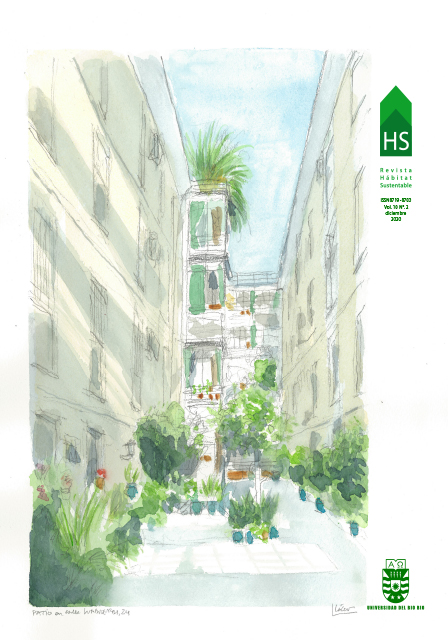Desempeño térmico de fachadas verdes tradicionales de orientación este en viviendas seriadas emplazadas en climas áridos
DOI:
https://doi.org/10.22320/07190700.2020.10.02.06Palavras-chave:
zonas áridas, ,arquitectura bioclimática, viviendas unifamiliares, Sistemas de Enverdecimiento VerticalResumo
La infraestructura verde constituye una estrategia de mitigación de las temperaturas urbanas y edilicias. El presente trabajo evalúa el impacto de un tipo de Sistema de Enverdecimiento Vertical (SEV), las Fachadas Verdes Tradicionales (FVT), en la condición térmica de viviendas localizadas en el Área Metropolitana de Mendoza, Argentina; cuyo clima es seco desértico (BWk - Köppen-Geiger). Con tal fin, se monitorearon, durante dos veranos consecutivos, dos casos de estudio: una vivienda con FVT, en orientación este, y una vivienda testigo de igual tipología y materialidad. Se registraron datos de temperatura ambiente exterior e interior; superficial exterior e interior y radiación horizontal. Se hallaron disminuciones de hasta 3.1°C en la temperatura ambiente interior de las viviendas con FVT, de hasta 27.4°C en muros exteriores y de 6.5°C en muros interiores. Las magnitudes de los resultados encontrados demuestran el potencial de la aplicación de esta estrategia en un clima árido.
Downloads
Referências
Alexandri, E. y Jones, P. (2008). Temperature decreases in an urban canyon due to green walls and green roofs in diverse climates. Building and Environment, 43(4), 480–493. DOI: https://doi.org/10.1016/j.buildenv.2006.10.055
Bustami, R. A., Belusko, M., Ward, J. y Beecham, S. (2018). Vertical greenery systems : A systematic review of research trends. Building and Environment, 146(August), 226–237. Recuperado de https://doi.org/10.1016/j.buildenv.2018.09.045
Coma, J., Pérez, G., De Gracia, A., Burés, S., Urrestarazu, M. y Cabeza, L. F. (2017). Vertical greenery systems for energy savings in buildings: A comparative study between green walls and green facades. Building and Environment, 111, 228–237. DOI: https://doi.org/10.1016/j.buildenv.2016.11.014
Contesse, M., Van Vliet, B. J. M. y Lenhart, J. (2018). Is urban agriculture urban green space? A comparison of policy arrangements for urban green space and urban agriculture in Santiago de Chile. Land Use Policy, 71(October), 566–577. DOI: https://doi.org/10.1016/j.landusepol.2017.11.006
Elsadek, M., Liu, B. y Lian, Z. (2019). Urban Forestry & Urban Greening Green façades : Their contribution to stress recovery and well-being in high- density cities. Urban Forestry & Urban Greening, 46(September). DOI: https://doi.org/10.1016/j.ufug.2019.126446
Gill, S. E., Handley, J. F., Ennos, A. R. y Pauleit, S. (2007). Adapting cities for climate change: The role of the green infrastructure. Built Environment, 33(1), 115–133. DOI: https://doi.org/10.2148/benv.33.1.115
Haggag, M., Hassan, A. y Elmasry, S. (2014). Experimental study on reduced heat gain through green façades in a high heat load climate. Energy and Buildings, 82, 668–674. DOI: https://doi.org/10.1016/j.enbuild.2014.07.087
Hoelscher, M. T., Nehls, T., Jänicke, B. y Wessolek, G. (2016). Quantifying cooling effects of facade greening: Shading, transpiration and insulation. Energy and Buildings, 114, 283–290. Recuperado de https://doi.org/10.1016/j.enbuild.2015.06.047
Kontoleon, K. J. y Eumorfopoulou, E. A. (2010). The effect of the orientation and proportion of a plant-covered wall layer on the thermal performance of a building zone. Building and Environment, 45(5), 1287–1303. DOI: https://doi.org/10.1016/j.buildenv.2009.11.013
Marchi, M., Pulselli, R. M., Marchettini, N., Pulselli, F. M. y Bastianoni, S. (2015). Carbon dioxide sequestration model of a vertical greenery system. Ecological Modelling, 306, 46–56. DOI: https://doi.org/10.1016/j.ecolmodel.2014.08.013
OCED / IEA. (2017). Energy Technology Perspectives 2017. International Energy Agency (IEA) Publications. Recuperado de https://webstore.iea.org/download/summary/237?fileName=English-ETP-2017-ES.pdf
Othman, A. R. y Sahidin, N. (2016). Vertical Greening Façade as Passive Approach in Sustainable Design. Procedia - Social and Behavioral Sciences, 222, 845–854. DOI: https://doi.org/10.1016/j.sbspro.2016.05.185
Pérez, G., Coma, J., Sol, S. y Cabeza, L. F. (2017). Green facade for energy savings in buildings: The influence of leaf area index and facade orientation on the shadow effect. Applied Energy, 187, 424–437. DOI: https://doi.org/10.1016/j.apenergy.2016.11.055
Perini, K., Ottelé, M., Fraaij, A. L. A., Haas, E. M. y Raiteri, R. (2011). Vertical greening systems and the effect on air flow and temperature on the building envelope. Building and Environment, 46(11), 2287–2294. DOI: https://doi.org/10.1016/j.buildenv.2011.05.009
Salas-Esparza, M. G. y Herrera-Sosa, L. C. (2017). La vegetación como sistema de control para las Islas de Calor Urbano en Ciudad Juárez, Chihuahua. Hábitat Sustentable, 7(1), 14-23. Recuperado de http://revistas.ubiobio.cl/index.php/RHS/article/view/2737
Suklje, T., Saso, M. y Arkar, C. (2016). On detailed thermal response modeling of vertical greenery systems as cooling measure for buildings and cities in summer conditions. Energy, 115, 1055–1068. DOI: https://doi.org/10.1016/j.energy.2016.08.095
Susorova, I., Angulo, M., Bahrami, P. y Stephens, B. (2013). A model of vegetated exterior facades for evaluation of wall thermal performance. Building and Environment, 67, 1–13. DOI: https://doi.org/10.1016/j.buildenv.2013.04.027
Vox, G., Blanco, I. y Schettini, E. (2018). Green façades to control wall surface temperature in buildings. Building and Environment, 129(September 2017), 154–166. DOI: https://doi.org/10.1016/j.buildenv.2017.12.002
Wong, I. y Baldwin, A. N. (2016). Investigating the potential of applying vertical green walls to high-rise residential buildings for energy-saving in sub-tropical region. Building and Environment, 97, 34–39. DOI: https://doi.org/10.1016/j.buildenv.2015.11.028
Wong, N. H., Kwang Tan, A. Y., Tan, P. Y., Chiang, K. y Wong, N. C. (2010). Acoustics evaluation of vertical greenery systems for building walls. Building and Environment, 45(2), 411–420. DOI: https://doi.org/10.1016/j.buildenv.2009.06.017
Downloads
Publicado
Como Citar
Edição
Secção
Licença
Direitos de Autor (c) 2020 Pablo Abel Suarez, María Alicia Cantón, Érica Correa

Este trabalho encontra-se publicado com a Licença Internacional Creative Commons Atribuição-CompartilhaIgual 4.0.
O conteúdo dos artigos publicados em cada número do Habitat Sustentável é da exclusiva responsabilidade dos autores e não representa necessariamente o pensamento ou compromete a opinião da Universidad del Bío-Bío.
Os autores mantêm os seus direitos de autor e concedem à revista o direito de primeira publicação da sua obra, que está simultaneamente sujeita à Licença de Atribuição Creative Commons CC BY-SA que permite a outros partilhar, transformar ou criar novo material a partir desta obra para fins não comerciais, desde que a autoria e a primeira publicação nesta revista sejam reconhecidas, e as suas novas criações sejam licenciadas sob os mesmos termos.











 Programa de Informação Científica/Concurso Fondos de Publicación de Revistas Científicas 2018/ Proyecto Mejoramiento de Visibilidad de Revistas UBB (Código:FP180007)
Programa de Informação Científica/Concurso Fondos de Publicación de Revistas Científicas 2018/ Proyecto Mejoramiento de Visibilidad de Revistas UBB (Código:FP180007)





